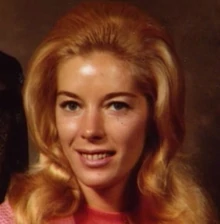The Death of Cindy James: Accident, Suicide, or Murder?
TRUE CRIME BEHIND THE FICTION
The true crime behind Lauren Carr’s international best-selling mystery, It’s Murder, My Son (a Mac Faraday Mystery)
I still remember the chills that would go up and down my spine when I’d pick up a Nancy Drew or Hardy Boys book to discover that the plot revolved around an unsolved mystery from long ago. From that, I grew into a huge fan of Unsolved Mysteries. I would mull over each mystery presented until the next week’s episode would add more mysteries to capture my imagination.
It is not unusual for a cold case mystery to send my imagination into overdrive. The writer in me will take a portion of the facts of the cases and blend them with a fictional characters and circumstance to create enjoyable adventures in mystery and suspense.
Such was the case of Cindy James, whose mysterious death and the circumstances leading up to it, was featured on Unsolved Mysteries. (https://unsolvedmysteries.fandom.com/wiki/Cindy_James ) The episode first aired on February 13, 1991. I had viewed the episode years later as part of an Unsolved Mysteries collection sold on DVD.
I only discovered recently while researching the current status of this unsolved case that the death of Cindy James has been the cause of much debate among armchair enthusiasts for decades.
The Death of Cindy James: Accident, Suicide, or Murder?

Victim: Cindy James
Full Name: Cynthia Elizabeth Hack James
Age: 44 years old
Location: Richmond, British Columbia
Date: June 8, 1989
On June 8, 1989, the body of forty-four-year-old Cindy James was found in the yard of an abandoned house only a few miles from her home in Richmond, a suburb of Vancouver, British Columbia. She had been drugged, strangled, and tied up with her hands and feet behind her back.
Sounds like a cut and dried case of murder, right? Maybe. Maybe not.
A nurse and administrator of a preschool for children with behavioral and emotional issues, Cindy James had endured seven years of mysterious and threatening phone calls. Menacing notes made from cut out letters from newspapers and magazines were left on her doorstep. She had filed close to a hundred complaints to the police and suffered violent physical attacks.
In January 1983, a friend dropped by Cindy’s house for a visit. When Cindy didn’t answer the door, the friend thought she was taking a bath. Then, she heard noises behind the house. When she went to investigate, she found Cindy on the ground with a nylon stocking tied around her neck. She said that someone had grabbed her from behind when she went out to the garage. All she saw her attacker’s white sneakers.
In December 1985, Cindy was found dazed in a ditch six miles from her house. She was suffering from hypothermia and covered with cuts and bruises. She was wearing a man’s work boot and glove and a black nylon stocking had been tied tightly around her neck. She had a needle mark in her arm and no memory of what happened.
Cindy took many steps to escape her stalker. She moved, changed the color of her car, and even her name. Still, the threats and attacks continued.
The police would conduct surveillance on her and her home in hopes of catching the culprit. The harassment would cease when they were watching. As soon as surveillance was called off, it would start up again.
With the police unable to get anywhere, Cindy hired a private investigator. He gave her a two-way radio. One night, when he heard strange noises over the radio, he went to her home and found her on the floor with a paring knife stabbed through her hand. In the hospital, she said she had been attacked and felt a needle in her arm.
However, the police found no fingerprints and or anyone to corroborate her description of what happened. Over time, the police started to question her stories and even began to suspect she was behind them.
Eventually, Cindy’s friend Agnes and her husband, Tom, stayed with her to help protect her. One night in April 1986, they woke up at three in the morning to find the basement on fire and the phone dead. Cindy noticed the flames when she was returning from walking her dog.
When Tom ran outside to go to the neighbors to call the fire department, he saw a man at the curb. When he called to him, the man ran down the street.
The police theorized that the perpetrator would have had to climb through a window to set the fire inside the house, but they found no dust or fingerprints disturbed on the outside of the windowsill. Also, they considered it odd that Cindy, who was in fear for her life, would go outside alone in the middle of the night to walk her dog.
That’s right. Investigators began to question the truth behind the harassment, threats, and attacks on Cindy James.
Their primary concern centered around Cindy’s refusal to give details to friends, family, and most importantly investigators about what was behind the stalking and attacks. The police investigated every incident and questioned Cindy several times. The private investigator that she had hired claimed that she would not tell them the entire story. She would be evasive and not act as a normal victim. For example, walking her dog alone at three o’clock in the morning. She also took a polygraph, which indicated deception.
Her family insisted that Cindy was reluctant to name her attacker because he had threatened her family.
Eventually, Cindy’s doctor committed her to a psychiatric ward because he believed that she was suicidal. After ten weeks, she left the hospital and admitted to friends and family that there was more going on than she had been saying.
Her father said that Cindy finally admitted to her family and friends that she knew more than she was saying. She told him that she believed she knew the identity of the perpetrator and would go after them herself.
The Death of Cindy James
In May 1989, Cindy disappeared. Her car was found in a local shopping plaza with groceries and a wrapped gift inside. There was blood on the driver’s side door. Items from her wallet were found under the car.
Two weeks later, Cindy’s body was found at the abandoned house close to the shopping plaza.
The scene had all of the markings of a brutal murder. Her hands and feet were bound together behind her back. A black nylon stocking was tied firmly around her neck. However, an autopsy revealed that Cindy James had died from an overdose of morphine, the sedative flurazepam, and other drugs.
The police concluded that Cindy James had committed suicide and closed this case in July 1989.
The coroner ruled that her death was not suicide, an accident, or a murder. They determined that she died of an “unknown event”.
How, you may ask, does someone commit suicide with their hands and feet tied behind their back? A journalist interviewed in the Unsolved Mysteries broadcast said that one of the investigators demonstrated this and was able to tie himself up in less than three minutes. The morphine and other drugs that caused the overdose would have taken fifteen minutes to knock her unconscious. Investigators believe Cindy injected herself with the drugs and then tied herself up before they took effect.
Motive: Investigators suspect that Cindy James suffered from multiple personalities, and one of her personalities was harassing and attacking and eventually murdered her.
One question kept running through my mind while hearing about this case. What information, secret, would be so important that someone would not reveal it even when she is terrified for her life?
Cindy’s family said that she had promised that she would tell them everything after she left the psychiatric hospital. However, she left the hospital in 1988. She died in May/June 1989 without revealing anything to anyone.
As a mystery writer, the fiction journey for the answer to this question led me to the plot for It’s Murder, My Son, the first installment of the Mac Faraday Mysteries.

Lauren Carr
Lauren Carr is the international best-selling author of the Mac Faraday, Lovers in Crime, Thorny Rose, Chris Matheson Cold Case Mysteries, and Nikki Bryant Cozy Mysteries—over twenty-five titles across five fast-paced mystery series filled with twists and turns!
Book reviewers and readers alike rave about how Lauren Carr seamlessly crosses genres to include mystery, suspense, crime fiction, police procedurals, romance, and humor.
The owner of Acorn Book Services, Lauren is also a publishing manager, consultant, and virtual book tour coordinator for independent authors.
Lauren is a popular speaker who has made appearances at schools, youth groups, and on author panels at conventions.
She lives with her husband, and two spoiled rotten German shepherds on a mountain in Harpers Ferry, WV.

Check out other posts by Lauren Carr





